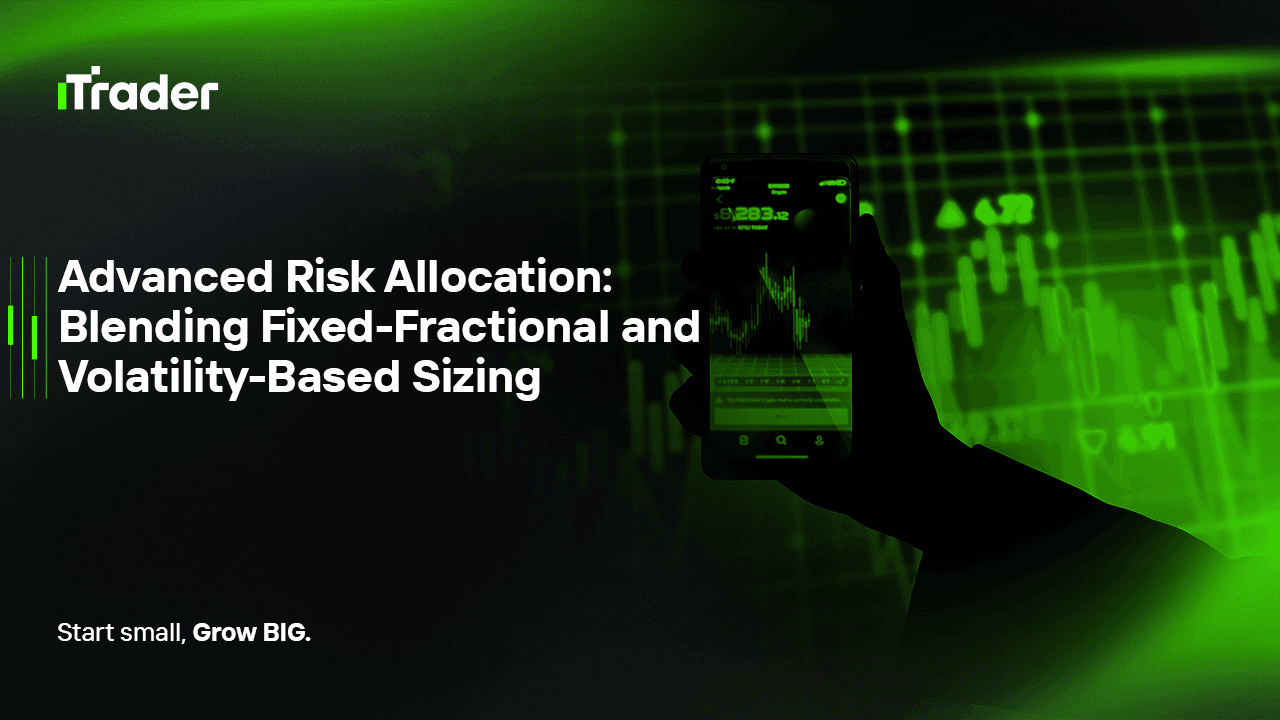2025-09-24
In forex trading, finding a profitable strategy is only the beginning. The real challenge lies in executing that strategy consistently while protecting your equity and surviving long enough to reap the benefits. Many traders fail not because their setups are poor but because their risk allocation framework is weak.
When it comes to passing prop firm evaluations, capital management is just as critical as trade entries. You need more than a “good trade idea” — you need a structured way of adjusting your position size and risk across different market conditions.

That’s where Fixed-Fractional (FF) and Volatility-Based (VB) methods come in. Each method offers unique strengths, but their limitations become clear when applied in isolation. The key lies in blending them into a hybrid model that balances account growth, equity protection, and adaptability.
This blog explores both approaches in detail, examines their pros and cons, and shows how prop traders can combine them into an advanced risk allocation framework.
The Fixed-Fractional method allocates risk as a fixed percentage of account equity — often 1–2% per trade.
Example:
The Volatility-Based method sizes trades relative to market volatility. Common measures include ATR (Average True Range) or standard deviation. Stop-losses are set based on volatility multiples, and lot sizes are calculated accordingly.
Example:
Each method covers a weakness of the other:
When combined:
This hybrid creates a dynamic, resilient framework for prop traders.
The biggest challenge isn’t the math — it’s the trader’s discipline. A perfect system fails if rules are ignored.
For hybrid risk allocation:
Neither Fixed-Fractional nor Volatility-Based sizing is flawless. Alone, each has structural weaknesses. Together, they provide:
For prop traders, success isn’t only about finding the “perfect setup.” It’s about surviving, scaling, and thriving under strict risk rules. A hybrid FF + VB risk allocation system delivers the balance required to achieve exactly that.
2025 Ай Трейдер Глобал ХХК | Компанийн бүртгэлийн дугаар: 15962
Ай Трейдер Глобал ХХК нь Комор улсын Анжуан арал дахь Мутсамуду хотын Хамчакод байрлалтай. Тус компани нь Коморын Үнэт Цаасны Хорооноос (Securities Commission of the Comoros) олгосон L15962/ITGL дугаартай тусгай зөвшөөрлийн хүрээнд үйл ажиллагаа явуулдаг.
Ай Трейдер Глобал ХХК нь “iTrader” нэрийн дор үйл ажиллагаа явуулдаг бөгөөд (Форекс) арилжааны үйл ажиллагаа явуулах эрхтэй. Компанийн лого, барааны тэмдэг, вэбсайт нь зөвхөн Ай Трейдер Глобал ХХК компанийн өмч юм.
Ай Трейдер Глобал ХХК -ийн охин компани болох : iTrader Global Pty Ltd, Австралийн компанийн бүртгэлийн дугаар (ACN): 686 857 198. Энэ компани нь Opheleo Holdings Pty Ltd компанийн албан ёсны төлөөлөгч бөгөөд Австралийн санхүүгийн үйлчилгээний төлөөлөгчийн дугаар: 001315037 -тай. Австралийн санхүүгийн үйлчилгээний лицензийн дугаар: 000224485 -тай Level 1, 256 Rundle St, Adelaide, SA 5000 хаягт байршдаг. Анхааруулга: Энэ байгууллага нь энэхүү вэбсайт дээр болон дамжуулан арилжаалагдаж буй санхүүгийн (арилжааны) хэрэгсэл нийлүүлэгч биш бөгөөд ямар нэгэн хариуцлага хүлээхгүй болно.
Эрсдэлийн сэрэмжлүүлэг: CFD арилжааны хөшүүргийн улмаас хөрөнгөө хурдан алдах өндөр эрсдэлтэй тул бүх хэрэглэгчдэд тохиромжгүй байдаг.
Фанд, CFD болон бусад өндөр xөшүүрэгтэй арилжаа нь хэрэглэгчээс нарийн төвөгтэй ойлголтуудын талаар тусгай мэдлэг шаарддаг. Хөшүүрэгтэй арилжаанд оролцогчдын 84.01% нь алдагдал хүлээдгийг судалгаанууд харуулдаг тул хөшүүрэгтэй арилжаанд орохоос өмнө хөрөнгөө алдах маш өндөр эрсдэлтэй болохыг анхаарна уу.
iTrader нь аливаа иргэн, хуулийн этгээдийн өмнө xөшүүрэгтэй арилжааны эрсдэл, алдагдал, бусад хохирлыг бүхэлд нь хариуцахгүй болохыг мэдэгдэж байна.
Энэхүү веб сайтын мэдээ, мэдээлэл нь зөвхөн мэдлэг түгээх зорилготой тул хэрэглэгч та бие даан шийдвэр гаргана уу.
Хязгаарлалт: iTrader нь вэбсайт болон үйлчилгээгээ тухайн орны хууль тогтоомж, дүрэм журмаар хориглосон орнуудад оршин суугчдад чиглүүлдэггүй. Хэрэв та энэхүү вэбсайтыг ашиглахыг хориглосон оронд байгаа бол вэбсайт болон үйлчилгээг ашиглахдаа тухайн орны хууль тогтоомжид нийцэж байгаа эсэхийг шалгах үүрэгтэй. iTrader нь вэбсайтынхаа мэдээлэл бүх оронд тохиромжтой эсэхийг баталгаажуулдаггүй.
Ай Трейдер Глобал ХХК нь зарим улс орны иргэдэд үйлчилгээ үзүүлэхээс татгалздаг болно. Жишээлбэл: АНУ, Орос, Бразил, Канада, Израйл, Иран.